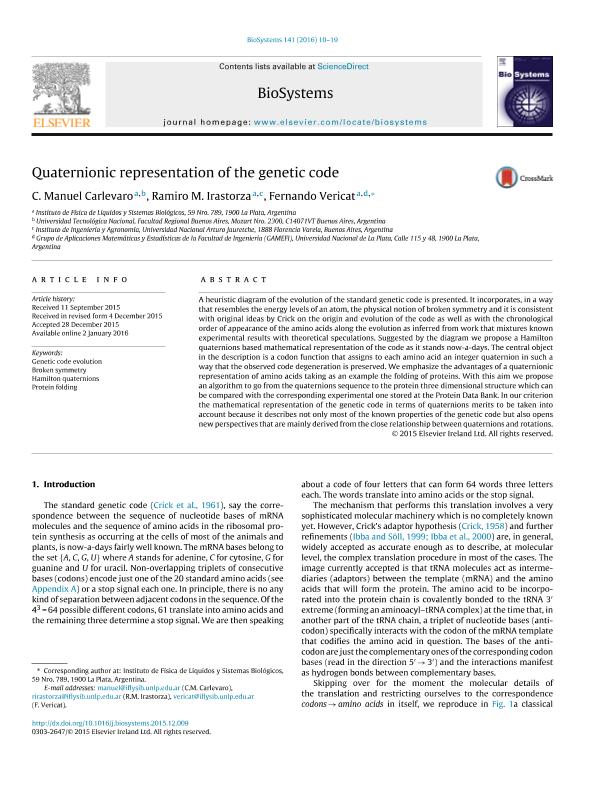Mostrar el registro sencillo del ítem
dc.contributor.author
Carlevaro, Carlos Manuel

dc.contributor.author
Irastorza, Ramiro Miguel

dc.contributor.author
Vericat, Fernando

dc.date.available
2018-03-06T18:13:03Z
dc.date.issued
2016-03
dc.identifier.citation
Carlevaro, Carlos Manuel; Irastorza, Ramiro Miguel; Vericat, Fernando; Quaternionic representation of the genetic code; Elsevier; Biosystems; 141; 3-2016; 10-19
dc.identifier.issn
0303-2647
dc.identifier.uri
http://hdl.handle.net/11336/37973
dc.description.abstract
A heuristic diagram of the evolution of the standard genetic code is presented. It incorporates, in a way that resembles the energy levels of an atom, the physical notion of broken symmetry and it is consistent with original ideas by Crick on the origin and evolution of the code as well as with the chronological order of appearance of the amino acids along the evolution as inferred from work that mixtures known experimental results with theoretical speculations. Suggested by the diagram we propose a Hamilton quaternions based mathematical representation of the code as it stands now-a-days. The central object in the description is a codon function that assigns to each amino acid an integer quaternion in such a way that the observed code degeneration is preserved. We emphasize the advantages of a quaternionic representation of amino acids taking as an example the folding of proteins. With this aim we propose an algorithm to go from the quaternions sequence to the protein three dimensional structure which can be compared with the corresponding experimental one stored at the Protein Data Bank. In our criterion the mathematical representation of the genetic code in terms of quaternions merits to be taken into account because it describes not only most of the known properties of the genetic code but also opens new perspectives that are mainly derived from the close relationship between quaternions and rotations.
dc.format
application/pdf
dc.language.iso
eng
dc.publisher
Elsevier

dc.rights
info:eu-repo/semantics/openAccess
dc.rights.uri
https://creativecommons.org/licenses/by-nc-nd/2.5/ar/
dc.subject
Broken Symmetry
dc.subject
Genetic Code Evolution
dc.subject
Hamilton Quaternions
dc.subject
Protein Folding
dc.subject.classification
Otras Ciencias Biológicas

dc.subject.classification
Ciencias Biológicas

dc.subject.classification
CIENCIAS NATURALES Y EXACTAS

dc.title
Quaternionic representation of the genetic code
dc.type
info:eu-repo/semantics/article
dc.type
info:ar-repo/semantics/artículo
dc.type
info:eu-repo/semantics/publishedVersion
dc.date.updated
2018-03-05T20:43:08Z
dc.journal.volume
141
dc.journal.pagination
10-19
dc.journal.pais
Países Bajos

dc.journal.ciudad
Amsterdam
dc.description.fil
Fil: Carlevaro, Carlos Manuel. Consejo Nacional de Investigaciones Científicas y Técnicas. Centro Científico Tecnológico Conicet - La Plata. Instituto de Física de Líquidos y Sistemas Biológicos. Universidad Nacional de La Plata. Facultad de Ciencias Exactas. Instituto de Física de Líquidos y Sistemas Biológicos; Argentina. Universidad Tecnológica Nacional. Facultad Regional Buenos Aires; Argentina
dc.description.fil
Fil: Irastorza, Ramiro Miguel. Consejo Nacional de Investigaciones Científicas y Técnicas. Centro Científico Tecnológico Conicet - La Plata. Instituto de Física de Líquidos y Sistemas Biológicos. Universidad Nacional de La Plata. Facultad de Ciencias Exactas. Instituto de Física de Líquidos y Sistemas Biológicos; Argentina. Universidad Nacional Arturo Jauretche. Instituto de Ingeniería y Agronomia; Argentina
dc.description.fil
Fil: Vericat, Fernando. Consejo Nacional de Investigaciones Científicas y Técnicas. Centro Científico Tecnológico Conicet - La Plata. Instituto de Física de Líquidos y Sistemas Biológicos. Universidad Nacional de La Plata. Facultad de Ciencias Exactas. Instituto de Física de Líquidos y Sistemas Biológicos; Argentina. Universidad Nacional de La Plata. Facultad de Ingeniería; Argentina
dc.journal.title
Biosystems

dc.relation.alternativeid
info:eu-repo/semantics/altIdentifier/url/http://www.sciencedirect.com/science/article/pii/S0303264715002087
dc.relation.alternativeid
info:eu-repo/semantics/altIdentifier/doi/http://dx.doi.org/10.1016/j.biosystems.2015.12.009
Archivos asociados
